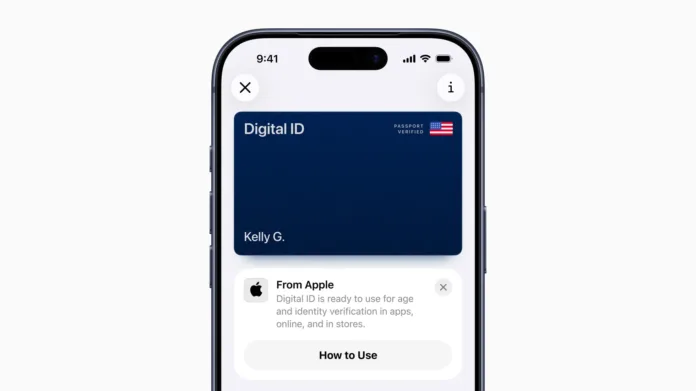Table of Contents
Apple has officially launched Digital ID, a major update to Apple Wallet app that allows users to create and present a secure digital version of their identity using information from a U.S. passport. With this new system, users can carry their identity directly on their iPhone or Apple Watch, presenting it in a privacy-focused, encrypted format that enhances convenience while maintaining strict security.
Check Out Our Article of Phished Data Now Powers Apple & Google Wallet Fraud Published on February 24th, 2025 SquaredTech
Apple Digital ID: A New Milestone in Secure Identity Verification
At launch, Apple confirmed that Digital ID will initially be accepted in beta at TSA checkpoints across more than 250 airports in the United States for identity verification during domestic travel. Over time, Apple plans to expand this acceptance to additional business and online use cases, signaling the company’s broader vision for digital identity integration.
According to Apple, this new feature provides a solution for individuals who do not yet possess a REAL ID-compliant driver’s license or state ID, giving them another way to verify their identity securely. However, Apple emphasized that Digital ID is not a replacement for a physical passport and cannot be used for international travel or border crossing.
Jennifer Bailey, Apple’s Vice President of Apple Pay and Apple Wallet, explained the company’s motivation behind this rollout. She said Apple aims to “expand the ways users can store and present their identity with the security and privacy built into iPhone and Apple Watch.” Bailey also noted that since Apple introduced the ability to add a driver’s license or state ID in 2022, user adoption has grown rapidly. The addition of Digital ID now extends that same secure convenience to millions more across the country.
This launch marks another phase in Apple’s larger digital identity initiative, which has been gradually expanding state by state and internationally. SquaredTech views this as Apple’s attempt to move beyond payments and access cards, transforming Apple Wallet into a central hub for verified credentials.
How to Create and Add a Digital ID in Apple Wallet
Apple has made the process of creating and storing a Digital ID in Apple Wallet straightforward while maintaining multiple layers of verification for authenticity and security. Users begin by tapping the Add (+) button at the top of the Wallet app on their iPhone. They then select Driver’s License or ID Cards, choose Digital ID, and follow detailed on-screen steps to start setup.
The setup involves several secure stages to confirm identity:
- Scanning the passport photo page using the iPhone’s camera.
- Reading the embedded passport chip with the phone’s NFC reader to verify data authenticity.
- Taking a selfie for live facial verification.
- Completing a short series of facial and head movements as an additional biometric check.
Once verified, the user’s Digital ID is stored locally on the device, not on Apple’s servers. This ensures that sensitive identity data remains private and under the user’s full control.
For users who do not own a U.S. passport, Apple notes that they can still add an eligible driver’s license or state ID to Apple Wallet, maintaining accessibility for a broader audience.
This process mirrors Apple’s standard security protocols — combining hardware-level encryption, biometric authentication, and local data storage to minimize exposure risks. Our analysts note that this multi-step verification method is one of the most advanced implementations of digital identification currently available from a consumer tech company.
How Apple Digital ID Works in Real-World Use
Once set up, users can present their Digital ID at supported TSA checkpoints and, in the future, at participating businesses and institutions. To access the ID, users simply double-click the side button or Home button on their iPhone or Apple Watch to open Apple Wallet, select Digital ID, and hold their device near an identity reader.
Before sharing information, users see a preview of exactly what data is being requested, allowing them to approve or deny each request using Face ID or Touch ID. This selective sharing ensures users maintain control over their personal details, preventing unnecessary exposure.
Apple has emphasized that users do not need to unlock or hand over their device when presenting their ID. Instead, the transaction happens securely between the user’s device and the authorized identity reader.
As Apple expands Digital ID use beyond airports, it plans to support identity and age verification at participating businesses, apps, and websites. This could include scenarios like verifying age for purchases, accessing secure online services, or confirming identity in professional environments.
Our team notes that Apple’s decision to make Digital ID compatible with both iPhone and Apple Watch demonstrates its focus on usability and accessibility. The ability to authenticate quickly via Face ID or Touch ID streamlines identification while preserving high security standards.
Digital Privacy and Security at the Core of Apple Digital ID
Apple has emphasized that Digital ID prioritizes privacy and encryption at every stage of storage and presentation. The passport data remains encrypted and stored directly on the user’s device, never uploaded to Apple’s servers. This means Apple cannot see when, where, or how users present their IDs.
Each transaction involving a Digital ID uses biometric authentication, ensuring that only the verified owner can access or share the information. Furthermore, only the specific data needed for a given verification is shared, reducing unnecessary disclosure.
Before any data is sent, users must review the request and authorize it with Face ID or Touch ID, reinforcing the consent-driven approach Apple is known for.
This design reflects Apple’s long-standing privacy philosophy: building features that operate securely on the device rather than relying on centralized databases. Our analysts point out that this could set a new benchmark for digital ID systems, especially in contrast to platforms that rely on cloud-based identity verification.
Apple’s Broader Identity Roadmap
The introduction of Digital ID in Apple Wallet is an extension of Apple’s ongoing initiative to digitize identity cards securely. Currently, users can already add a driver’s license or state ID in 12 U.S. states and Puerto Rico, including recent expansions to Montana, North Dakota, and West Virginia.
This year, Apple also introduced international support in Japan, where users can store their My Number Card digitally in Apple Wallet, demonstrating that the company’s identity technology is adaptable to regional standards.
By combining Digital ID with its existing identity ecosystem, Apple is building a global framework for secure digital verification. Over time, the company aims to make Apple Wallet a comprehensive identity platform for government services, travel, healthcare, and online transactions.
From our perspective, Apple’s steady expansion into digital identity signals its ambition to make Apple Wallet an all-in-one credential hub — similar to how Apple Pay revolutionized digital payments a decade ago.
A Major Step Toward a Digital-First Identity Future
We view Apple’s Digital ID for Apple Wallet as more than just a product update. It represents a turning point in how personal identity will be handled in the digital age. By combining passport data with encrypted local storage, Apple is creating a model that balances convenience, trust, and control.
The integration of Digital ID into Apple Wallet reinforces Apple’s position as a privacy leader. Every component — from on-device encryption to biometric authentication — reflects a user-first philosophy that avoids unnecessary data collection.
This approach could also influence future regulatory discussions on digital identification. Governments and institutions may begin exploring similar encrypted, device-based ID systems that reduce data breaches and identity theft risks.
From a user standpoint, Digital ID simplifies verification without compromising privacy. It lets travelers move through TSA checkpoints faster and, in the future, could eliminate the need to carry physical IDs for age or identity checks in many everyday situations.
Apple’s progress with Digital ID, combined with its global identity partnerships, points to a near future where digital credentials are universally accepted. It’s a logical step for Apple Wallet — transforming it from a payment tool into a secure digital identity platform.
Final Thoughts
Apple’s Digital ID in Apple Wallet is a clear example of how technology can enhance everyday security while maintaining simplicity. By using verified passport data and advanced encryption, Apple has built a system that respects user privacy without sacrificing ease of use.
At SquaredTech, we believe this development could reshape how users interact with institutions that require identification, setting a new standard for digital trust and personal data protection. As Apple continues expanding its identity ecosystem across more states and countries, Digital ID will likely become one of the most influential additions to the Apple Wallet platform.
For users and businesses alike, Apple’s Digital ID represents the beginning of a future where identification is digital, secure, and controlled entirely by the individual.
Stay Updated: Tech News


